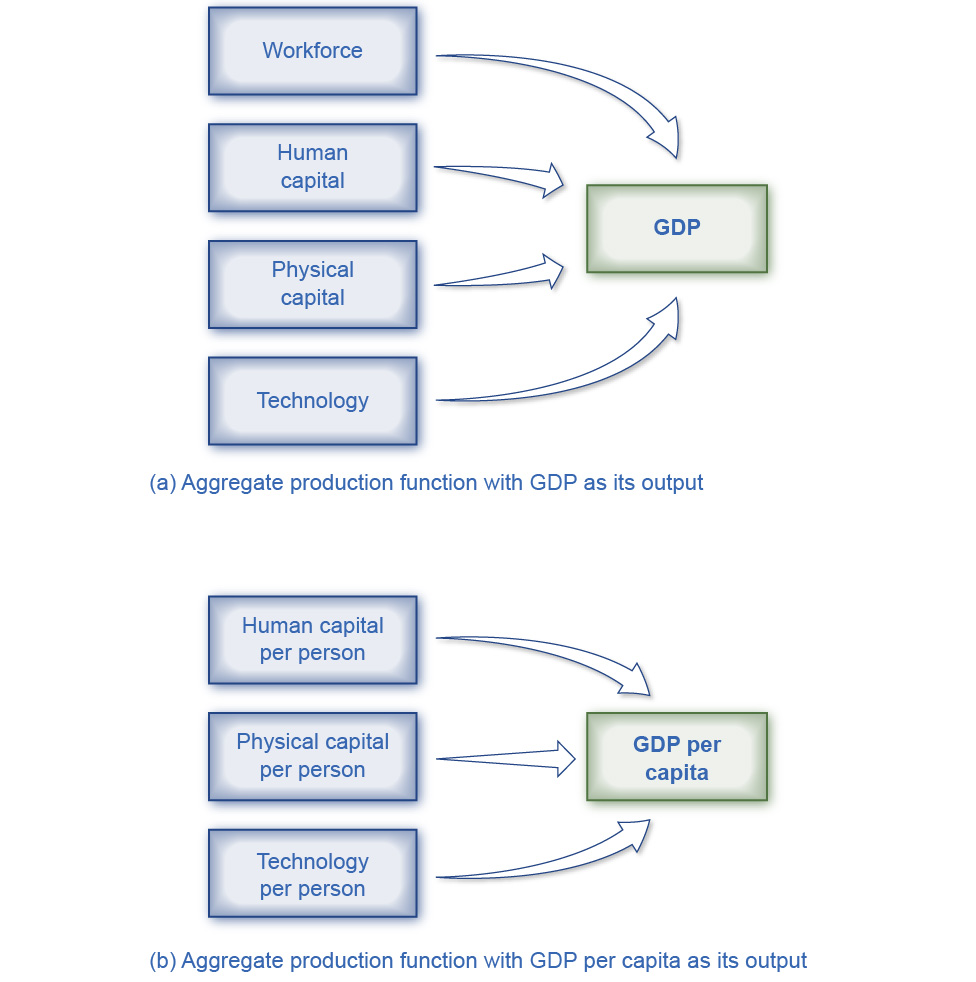26 Labor Productivity and Economic Growth
Labor Productivity and Economic Growth
Learning Objectives
By the end of the section, you will be able to:
- Identify the role of labor productivity in promoting economic growth
- Analyze the sources of economic growth using the aggregate production function
- Measure an economy’s rate of productivity growth
- Evaluate the power of sustained growth
Sustained long-term economic growth comes from increases in worker productivity, which essentially means how well we do things. In other words, how efficient is your nation with its time and workers?
Labor productivity is the value that each employed person creates per unit of their input. The easiest way to comprehend labor productivity is to imagine a Canadian worker who can make 10 loaves of bread in an hour versus a U.S. worker who in the same hour can make only two loaves of bread. In this fictional example, the Canadians are more productive.
More productivity essentially means you can do more in the same amount of time. This in turn frees up resources for workers to use elsewhere.
What determines how productive workers are?
The answer is pretty intuitive. The first determinant of labor productivity is human capital. Human capital is the accumulated knowledge (from education and experience), skills, and expertise that the average worker in an economy possesses. Typically the higher the average level of education in an economy, the higher the accumulated human capital and the higher the labor productivity.
The second factor that determines labor productivity is technological change. Technological change is a combination of invention—advances in knowledge—and innovation, which is putting those advances to use in a new product or service. For example, the transistor was invented in 1947. Developing the transistor has allowed workers to be anywhere with smaller devices. People can use these devices to communicate with other workers, measure product quality or do any other task in less time, improving worker productivity.
The third factor that determines labor productivity is economies of scale. Recall that economies of scale are the cost advantages that industries obtain due to size. A Canadian worker who could produce 10 loaves of bread in an hour. If this difference in productivity was due only to economies of scale, it could be that the Canadian worker had access to a large industrial-size oven while the U.S. worker was using a standard residential size oven.
Now that we have explored the determinants of worker productivity, let’s turn to how economists measure economic growth and productivity.
Sources of Economic Growth: The Aggregate Production Function
To analyze the sources of economic growth, it is useful to think about a production function, which is the technical relationship by which economic inputs like labor, machinery, and raw materials are turned into outputs like goods and services that consumers use. In macroeconomics, we call the connection from inputs to outputs for the entire economy an aggregate production function.
Components of the Aggregate Production Function
Economists construct different production functions depending on the focus of their studies. Figure 20.2 presents two examples of aggregate production functions. In the first production function in Figure 20.2 (a), the output is GDP. The inputs in this example are workforce, human capital, physical capital, and technology. We discuss these inputs further in the module, Components of Economic Growth.
Figure 20.2 Aggregate Production Functions An aggregate production function shows what goes into producing the output for an overall economy. (a) This aggregate production function has GDP as its output. (b) This aggregate production function has GDP per capita as its output. Because we calculate it on a per-person basis, we already figure the labor input into the other factors and we do not need to list it separately.
Measuring Productivity
An economy’s rate of productivity growth is closely linked to the growth rate of its GDP per capita, although the two are not identical. For example, if the percentage of the population who holds jobs in an economy increases, GDP per capita will increase but the productivity of individual workers may not be affected. Over the long term, the only way that GDP per capita can grow continually is if the productivity of the average worker rises or if there are complementary increases in capital.
A common measure of U.S. productivity per worker is dollar value per hour the worker contributes to the employer’s output. This measure excludes government workers, because their output is not sold in the market and so their productivity is hard to measure. It also excludes farming, which accounts for only a relatively small share of the U.S. economy
The Power of Sustained Economic Growth
Nothing is more important for people’s standard of living than sustained economic growth. Even small changes in the rate of growth, when sustained and compounded over long periods of time, make an enormous difference in the standard of living.
Access for free at https://openstax.org/books/principles-economics-3e


